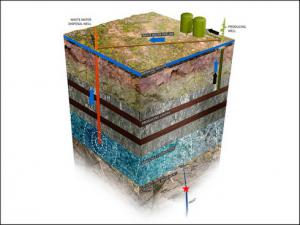EarthquakesFracking linked to most induced earthquakes in western Canada
A survey of a major oil and natural gas-producing region in Western Canada suggests a link between hydraulic fracturing or “fracking” and induced earthquakes in the region. The study’s findings differ from those reported from oil and gas fields in the central United States, where fracking is not considered to be the main cause of a sharp rise in induced seismicity in the region. Instead, the proliferation of hundreds of small earthquakes in that part of the United States is thought to be caused primarily by massive amounts of wastewater injected back into the ground after oil and gas recovery.

Deep well-injected wastewater linked to earthquakes // Source: stanford.edu
A survey of a major oil and natural gas-producing region in Western Canada suggests a link between hydraulic fracturing or “fracking” and induced earthquakes in the region, according to a new report published in the journal Seismological Research Letters.
The study’s findings differ from those reported from oil and gas fields in the central United States, where fracking is not considered to be the main cause of a sharp rise in induced seismicity in the region. Instead, the proliferation of hundreds of small earthquakes in that part of the United States is thought to be caused primarily by massive amounts of wastewater injected back into the ground after oil and gas recovery.
SSA notes that the SRL study does not examine why induced seismicity would be linked to different processes in the central United States and western Canada. However, some oil and gas fields in the United States, especially Oklahoma, use “very large amounts of water” in their operations, leading to much more wastewater disposal than in Canadian operations, said Gail M. Atkinson of Western University.
It is possible that massive wastewater disposal in the United States is “masking another signal” of induced seismicity caused by fracking, Atkinson said. “So we’re not entirely sure that there isn’t more seismicity in the central U.S. from hydraulic fracturing than is widely recognized.”
The fracking process uses high-pressure injections of fluid to break apart rock and release trapped oil and natural gas. Both fracking and wastewater injections can increase the fluid pressure in the natural pores and fractures in rock, or change the state of stress on existing faults, to produce earthquakes.
The Western Canada Sedimentary Basin (WCSB) contains one of the world’s largest oil and gas reserves, and is dotted with thousands of fracking wells drilled in multi-stage horizontal operations. Atkinson and her colleagues compared the relationship of 12,289 fracking wells and 1236 wastewater disposal wells to magnitude 3 or larger earthquakes in an area of 454,000 square kilometers near the border between Alberta and British Columbia, between 1985 and 2015.
The researchers performed statistical analyses to determine which earthquakes were most likely to be related to hydraulic fracturing, given their location and timing. The analyses identified earthquakes as being related to fracking if they took place close to a well and within a time window spanning the start of fracking to three months after its completion, and if other causes, such as wastewater disposal, were not involved.
Atkinson
